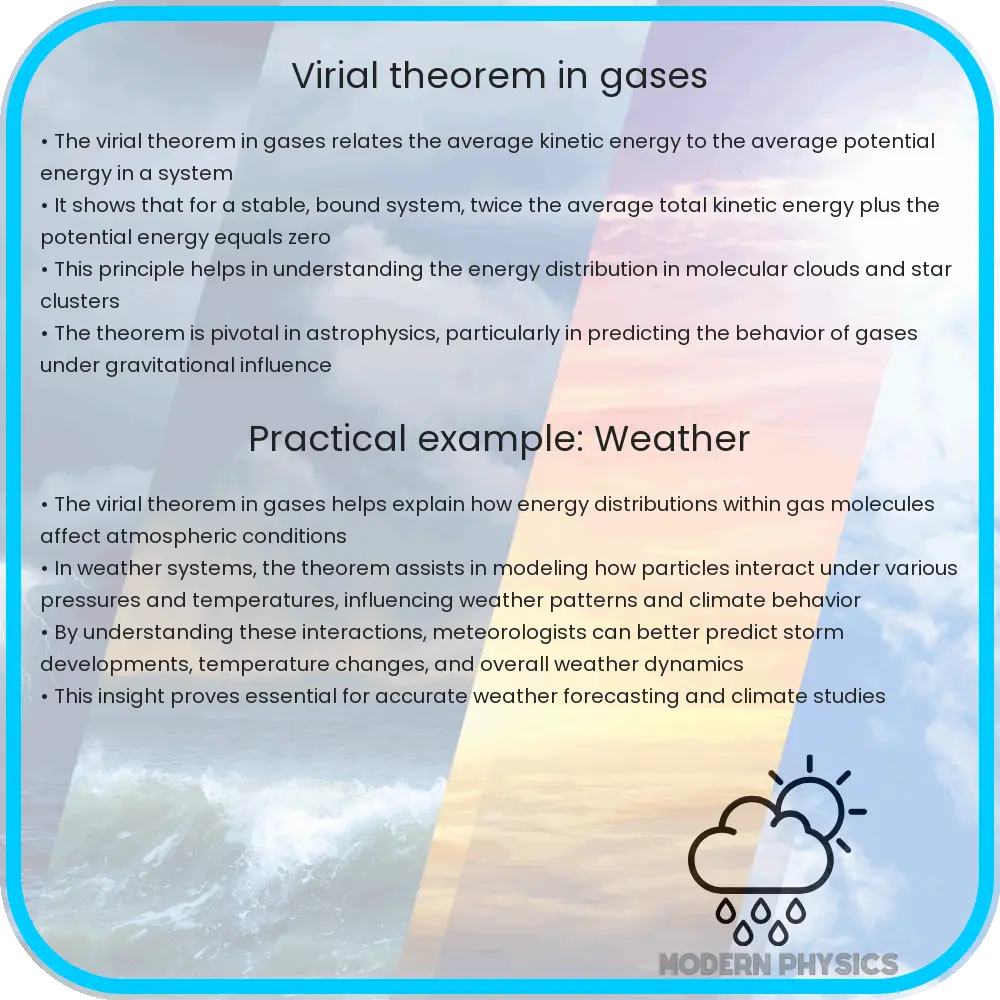Explore the Virial Theorem’s role in gases, with insights into its applications in astrophysics, molecular physics, and climate modeling.

Understanding the Virial Theorem in Gases
The Virial Theorem offers vital insights into the behavior of gases, especially in astrophysical and molecular contexts. This theorem, integral to the fields of physics and chemistry, relates the average over time of the total kinetic energy of a system with its potential energy. In the context of gases, it provides a profound understanding of the dynamics of gas molecules under various conditions.
Insights from the Virial Theorem
At its core, the Virial Theorem is an expression of the conservation of energy, highlighting the relationship between kinetic and potential energies in a system. In a gas, these energies are represented by the movement of particles and the forces between them, respectively. The theorem is particularly insightful in explaining the behavior of non-ideal gases, where interactions between particles are significant.
Applications in Different Fields
One of the key applications of the Virial Theorem is in astrophysics, particularly in understanding the stability of star clusters and galaxies. It helps in determining the balance between gravitational forces and internal pressures, crucial for predicting the life cycle of stars and the evolution of galaxies. Additionally, in the field of molecular physics, it aids in analyzing molecular interactions and understanding the thermodynamics of gases under different temperature and pressure conditions.
Analysis of Gaseous Systems
The theorem is applied in analyzing gaseous systems by considering the sum of all pairwise potential energies (V) and relating it to the total kinetic energy (T). The mathematical expression of the theorem is:
T = -1/2 Σi Σj rij (dV/drij)
Here, rij is the distance between particles i and j, and dV/drij is the derivative of the potential energy with respect to this distance. This relation is pivotal in understanding the stability and dynamics of gaseous systems.
Conclusion
In conclusion, the Virial Theorem in gases offers profound insights into the behavior and dynamics of gaseous systems. Its application ranges from astrophysical phenomena to molecular interactions, making it a cornerstone in the study of gases. The theorem not only elucidates the relation between kinetic and potential energies but also plays a critical role in understanding the stability and evolution of various systems.
Detailed Applications of the Virial Theorem
In practical scenarios, the Virial Theorem is used to derive equations of state for gases, especially non-ideal gases. This is crucial in industries like chemical engineering and environmental science, where understanding the behavior of gases under various pressures and temperatures is essential. For instance, the theorem aids in predicting the behavior of greenhouse gases in the atmosphere, which is vital for climate modeling.
Enhancing Understanding of Molecular Forces
Another intriguing application is in the realm of molecular physics. The Virial Theorem helps in determining the forces acting within molecules. By analyzing the potential energy terms, scientists can deduce intermolecular forces like Van der Waals forces, hydrogen bonding, and ionic interactions. This is particularly useful in the field of material science for designing materials with specific properties.
Role in Astrophysics and Cosmology
The theorem also finds extensive use in astrophysics. It helps in understanding the dynamics of interstellar gas clouds, which are precursors to star formation. In cosmology, the Virial Theorem is instrumental in studying the dynamics of galaxy clusters and in estimating the mass of dark matter within these clusters, providing crucial insights into the universe’s large-scale structure.
Challenges and Limitations
Despite its wide applications, the Virial Theorem has limitations. Its accuracy depends on the system being in a quasi-equilibrium state and on the correct formulation of potential energy, which can be complex in many-particle systems. Additionally, in quantum mechanical systems, its application requires careful consideration of quantum effects, which can alter the classical interpretation of the theorem.
Conclusion
The Virial Theorem is a fundamental tool in understanding the dynamics of gases, with applications spanning from industrial gas processes to the vastness of astrophysical phenomena. It provides essential insights into the kinetic and potential energy interactions in various systems, from molecular to cosmic scales. While it has certain limitations, particularly in quantum systems, its role in advancing our understanding of the natural world remains undisputed. The theorem continues to be a subject of research and development, promising new insights and applications in the future.
